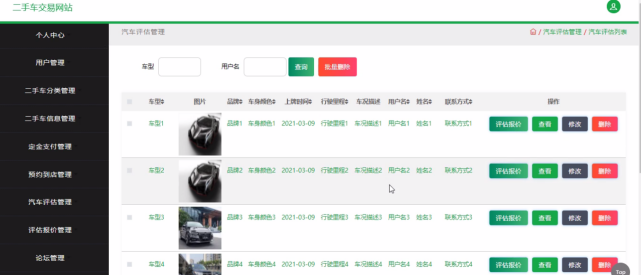概述
本文档旨在描述在WSF中对象之间交互所使用的方程和算法。这包括:
- 传感器交互
- 通信交互
- 干扰(干扰)交互
常见无线电频率方程
WSF使用一套通用类来封装涉及无线电频率(RF)交互的组件(实际上,这些类的一些特性也用于非RF交互,但这里并不重要)。文档的第一部分将处理信号传输和接收的基础知识。后续部分将处理特定应用(雷达、合成孔径雷达(SAR)、电子支援测量(ESM)、干扰和通信)。
忽略接收信号处理的细节,RF交互可以分为两类:
- 直接或单向:即发射的信号直接发送到接收器
- 间接或双向:即发射的信号从物体反射后再被接收
接收信号功率的计算可以分为几个独立的步骤:
- 从发射天线的发射
- 到达目标或接收器的传播
3.对于间接或双向交互:
1. 从目标的反射
2. 从目标到接收器的传播
4. 接收天线的接收
直接传输功率的计算
![]()
| Symbol | Source | Description |
|---|---|---|
|
| transmitter antenna_pattern | The gain of the transmitting antenna in the direction of the target object (receiver or platform). This includes any electronic beam steering losses (Equation RF.6) |
|
| transmitter internal_loss | The internal losses in the transmitter between the power source and the antenna |
|
| transmitter power | The peak power of the transmitter. This should be the power of a single pulse. |
|
| Computed | The transmitted power. |
信号在自由空间中的传播
从源(s)到目的地(d)的自由空间信号传播使用以下方程进行计算。在单向交互中,‘s’和‘d’分别是发射器和接收器(方程RF.2b)。在双向交互中,存在两条传播路径。第一条是从发射器到目标(方程RF.2c),第二条是从目标到接收器(方程RF.2d)。
|
| General form | (RF.2a) |
|
| Transmitter - to - receiver | (RF.2b) |
|
| Transmitter - to - target | (RF.2c) |
|
| Target - to - receiver | (RF.2d) |
| Symbol | Source | Description |
|---|---|---|
|
| transmitter attenuation_model | The fraction of the signal that remains after computing the effects of atmospheric attenuation while propagating the signal from the source (d) to the destination (d). |
|
| Computed | The computed free space power density at the destination (s) that originated from the source (d) |
|
| Computed | The power emitted from the source (s). This will be either the transmitted power (Equation RF.1) or the reflected power from a target (Equation RF.3) |
|
| Computed | The slant range from the source (s) to the destination (d) |
反射自由空间信号
一个反射自由空间信号的目标有效地创建了一个新的“发射源”。该源的功率等于入射信号的信号密度与反射源的有效面积的乘积。反射器可以是一个平台(例如,在进行双向雷达交互时),也可以是地球表面(在进行杂波计算时)。然后,可以通过应用方程RF.2将反射功率传播到接收器。
![]()
| Symbol | Source | Description |
|---|---|---|
|
| Equation RF.2c | The power density at the target (t) of the signal that originated from the transmitter (x). |
|
| Computed | The power created by the reflection of the incoming signal off of the target. |
|
| radar_signature | The radar cross section of the target. |
自由空间信号的接收
RF.4a用于直接的单向(通信、被动射频和干扰)。 RF.4b用于双向(雷达、合成孔径雷达)。
|
| One-way, Transmitter - to - receiver | (RF.4a) |
|
| Two-way, Target - to - receiver | (RF.4b) |
| Symbol | Source | Description |
|---|---|---|
|
| See section 2.5 | The fraction of the received signal that is admitted, accounting for possible mismatches in the frequency/bandwidth of the transmitted and the frequency/bandwidth of the receiver. Note: This is not incorporated for radar interactions because it is assumed that the transmitter and receiver are matched. |
|
| transmitter_polarization receiver_polarization polarization_effects antenna_pattern | The fraction of the received signal that is admitted, accounting for possible mismatches in the polarization of the transmitter and the receiver. Note: This is not incorporated for radar interactions because it is assumed that the transmitter and receiver are matched. |
|
| transmitter propagation_model | The pattern propagation factor. This accounts for the constructive/destructive interference between the direct and indirect signal paths. Note: This is current only implemented for radar interactions. |
|
| Equation RF.2b | The power density at the receiver of the signal that originated from the transmitter |
|
| Equation RF.2d | The power density at the receiver of the signal that was reflected from the target |
|
| receiver antenna_pattern | The gain of the receiving antenna in the direction of the target object (receiver or platform). This includes any effects of electronic beam steering (Equation RF.6) |
|
| receiver internal_loss | The internal losses in the receiver between the output of the antenna and the receiver |
|
| Computed | The received power. |
带宽比
因子FBW用于考虑发射器频谱可能与接收器调谐带不匹配的事实。它是发射器频谱在接收器调谐带内的分数
|
| Lower Frequency of transmitted spectrum |
|
| Upper Frequency of transmitted spectrum |
|
| Lower tuning frequency of the receiver |
|
| Upper tuning frequency of the receiver |
| Symbol | Source | Description |
|---|---|---|
|
| receiver bandwidth | The bandwidth of the receiver. |
|
| transmitter bandwidth | The bandwidth of the transmitter. |
|
| receiver frequency | The center frequency of the range of frequencies the receiver can receive. |
|
| transmitter frequency | The center frequency of the transmitter frequency spectrum |
FBW的最终值取决于发射器和接收器的上限频率和下限频率之间的关系。
![]()
![]()
![]()
接收器噪声功率
以下定义适用于接收器噪声功率的计算:
| Symbol | Source | Description |
|---|---|---|
|
| Internal constant | Boltzmann’s constant (1.3806505E-23 J/deg-K) |
|
| receiver bandwidth – or – transmitter pulse_width | The bandwidth of the receiver. If the bandwidth was not specified AND if the transmitter is pulsed, the bandwidth will be computed as (1 / pulse_width) (i.e.: A matched filter will be assumed). |
|
| Computed | The noise power |
|
| receiver noise_figure | The receiver noise figure (default 1.0) |
|
| Internal constant | Standard temperature (290 deg-K) |
|
| Computed | The system noise temperature. |
噪声功率将使用以下过程进行计算。将使用满足使用条件的第一步的值:
1 如果指定了噪声功率,则使用定义的值。
2 如果无法确定带宽,则使用-160 dBW的值。
3 如果指定了噪声系数,并且未包含天线损耗和接收线路损耗,则计算噪声功率:
![]()
4 使用“雷达范围性能”中定义的算法计算噪声功率,作者:Lamont V. Blake,1986年,Artech House, Inc.,第4章。
Noise temperature due to the antenna (![]() = sky temperature due to the antenna pointing angle):
= sky temperature due to the antenna pointing angle):
Noise temperature contribution due to receive line loss:
Noise temperature contribution due to the receiver:
math:`T_r = T_0 times (noise_figure - 1.0)text{ (RF.6d)}
Total system temperature:
Noise power:
天线增益模式
每个发射器和接收器都有其相关的天线增益模式。天线模式是通过全局 antenna_pattern 命令创建的。通过在发射器和接收器模块中使用 antenna_pattern 命令,可以将天线模式附加到发射器或接收器上。如果未为发射器或接收器选择天线模式,则假定增益为1.0。
增益模式是相对于模式原点(通常是视轴或指向角)在方位角和高度角上的函数。对于给定的交互,计算感兴趣点相对于模式原点的方位角和高度角。
天线增益模式可以通过几种方式表示:
- 提供增益与方位角和高度角关系的矩形表。
- ALARM 表。
- 均匀(常数)模式。
- 循环 sin(x)/x 模式。
- 矩形 sin(x)/x 模式。
- 余弦正弦模式。
- GENAP 模式(GENAP 是政府 TRAMS 模型中提供的一种广义天线模式例程的子集)。
可以使用多个表的集合来形成一个复合的极化和频率模式。
电子指向波束的增益可以选择性地修改,以包括将波束指向偏离阵列法线角度的效果。通过在发射器或接收器中使用 electronic_beam_steering 命令启用此功能。可以使用以下方程:
![]()
| Symbol | Source | Description |
|---|---|---|
|
| antenna_pattern | The unmodified gain of the antenna when looking at the point of interest. |
|
| Computed | The gain, modified to include the effects of electronic beam steering. |
|
| Computed | The angle between the normal to the antenna face and the vector to the point of interest. |
|
| electronic_beam_steering_loss_exponent | An optional exponent to reflect the amount of degradation of the gain as the beam is moved away form the normal of the antenna face. |
大气衰减
大气衰减的计算通过发射模块中的 atmospheric_attenuation 命令实现。
当前可用的模型有两个。这些模型提取自 SUPPRESSOR,只适用于地面系统(这些表假定发射器位于地面)。
-
blake - 由海军研究实验室的 L.V. Blake 编写的大气吸收模型。该模型基于42条在100 MHz到10 GHz之间的频率和0到10度之间的高度角的衰减曲线。300海里之外的曲线是平坦的。这些表格已发表在《雷达系统分析》第15.1节,David K. Barton, Artech Publishing。
-
earce - 来自 ESAMS/ALARM/RADGUNS 通用环境 (EARCE) 的大气吸收模型。这是一个有效范围为100 MHz到18 GHz以及27 GHz到40 GHz的预计算表的集合。频率小于100 MHz将假设为100 MHz。18 GHz至27 GHz和40 GHz以上的频率将使用一种计算密集的方法来确定衰减,应尽量避免使用。
另一个基于国际电信联盟 (ITU) 推荐 ITU-R P.676 的模型正在开发中。该实现将适用于空中和地面平台,并支持更广泛的频率范围。
传播算法
传播效应(大气衰减以外的效应)的计算通过发射模块中的 propagation_model 命令实现。
目前支持一个模型:
- fast_multipath - 该模型实现了在《雷达范围性能分析》中定义的方法,作者是 Lamont V. Blake, 1986年, Artech House, Inc。它计算由于信号在粗糙的圆形地面反射引起的建设性或破坏性干涉的效果。可以提供两个因素以定义反射点表面的属性。
噪声算法
目前,WSF 仅限于表示噪声的能力非常有限。通过接收模块中的 clutter_model 命令启用噪声的使用。目前唯一的选择是利用噪声表,且该表尚未经过验证。
雷达传感器 (WSF_RADAR_SENSOR)
WSF_RADAR_SENSOR 模型有效地计算单个脉冲(或连续波形)的功率,然后计算多次脉冲积分的效果。
接收功率的计算
应用方程 RF.1 到 RF.4,用于计算单个脉冲(或连续波形)的接收功率。请注意,这不包括干扰。干扰问题将在另一个步骤中处理。

信号处理与检测
处理后的信号计算如下:
![]()
| Symbol | Source | Description |
|---|---|---|
|
| adjustment_factor | A general adjustment factor that can be used to account for other constant effects that are not provided by the model. |
|
| integration_gain | The gain due to the integration of multiple pulses. Note: This is computed internally if swerling_case is specified. |
|
| transmitter pulse_compression_ratio | The pulse compression ratio |
|
| Equation Radar.1 | The received power |
|
| Computed | The processed power. |
The signal to noise is computed as:
![]()
| Symbol | Source | Description |
|---|---|---|
|
| receiver clutter_model | The clutter power |
|
| Equation Jam.1 | The incident jammer power. This is computed as the sum of the incident power on the radar receiver at the time of the detection interaction. |
|
| Equation RF.6 | The receiver noise power |
|
| Equation Radar.2 | The processed power. |
|
| Computed | The signal-to-noise (or interference) ratio. |
目标检测
目标的检测由两种机制之一决定。可以通过指定检测阈值(detection_threshold)使用一个简单的二元检测器。如果信号与噪声比超过该阈值,则声明成功检测。
也可以使用 Marcum-Swerling 检测器,它将针对给定的信号与噪声比产生检测概率。如果计算出的检测概率超过所需的检测概率,则声明成功检测。可以通过使用 swerling_case、number_of_pulses_integrated、probability_of_false_alarm 和 detector_law 命令来选择此检测器。
被动射频传感器 (WSF_ESM_SENSOR)
被动射频计算(ESM, RWR)利用单向方程。
“r”下标值代表被动射频接收器,“x”下标值代表传感器、干扰器或通信发射机。扩展方程如下:

The signal-to-noise is computed as:
![]()
| Symbol | Source | Description |
|---|---|---|
|
| Equation RF.6 | The receiver noise power |
|
| Equation ESM.1 | The processed power. |
|
| Computed | The signal-to-noise (or interference) ratio. |
成功检测声明
如果信噪比(SN)超过以下定义的阈值,则声明成功检测:
- 如果传输信号为脉冲,则使用
pulsed_detection_threshold的值。 - 如果传输信号为非脉冲,则使用
continuous_detection_threshold的值。 - 如果未指定上述任何阈值,则使用
detection_threshold的值。
SAR 传感器 (WSF_SAR_SENSOR)
SAR 计算是雷达计算的扩展。
TODO:杂波计算,多普勒折叠
所需采集时间
用于计算收集所需图像的时间以达到期望分辨率的方程是:
![]()
| Symbol | Source | Description |
|---|---|---|
|
| Computed | The desired azimuth resolution |
|
| doppler_overcollect_ratio | The overcollect ratio (default 1.0) |
|
| Computed | The slant range from the sensor to the image center |
|
| Computed | The ground speed of the sensing platform. |
|
| transmitter frequency -or- wavelength | The frequency of the transmitted signal |
|
| Computed | The azimuth angle between the ground track of the sensing platform and the vector to the image center. |
|
| Computed | The azimuth angle between the ground |
RF 干扰器 (WSF_RF_JAMMER)
干扰计算利用单向方程,其中发射器是干扰器,接收器是雷达或通信接收器。干扰计算在雷达检测或通信尝试发生时进行。WSF 将对每个可能影响输出的干扰器的功率进行求和(即:如果存在会影响接收器的带内功率)。
“r”下标值代表传感器或通信接收器,而“x”值代表干扰发射器。扩展方程如下:

通信 (WSF_RADIO_TRANSCEIVER)
通信计算使用单向方程。
“r”下标值代表通信接收器,而“x”值代表通信发射器。扩展方程如下:

信噪比的计算公式为:
![]()
| Symbol | Source | Description |
|---|---|---|
|
| Equation Jam.1 | The incident jammer power. This is computed as the sum of the incident power on the receiver at the time of the interaction. |
|
| Equation RF.6 | The receiver noise power |
|
| Equation Comm.1 | The processed power. |
|
| Computed | The signal-to-noise (or interference) ratio. |
通信尝试成功声明
如果信噪比(SN)超过接收器的检测阈值,则声明通信尝试成功。
红外搜索跟踪传感器 (WSF_IRST_SENSOR)
计算目标辐照度
-
确定背景辐射。这包括相对简单的能力,用于考虑仰视天空或俯视地面的影响。
-
计算对比辐射强度。
![]()
| Symbol | Source | Description |
|---|---|---|
|
| platform infrared_signature | The source radiant intensity (infrared radiant intensity) of the target |
|
| The background radiant intensity | |
|
| platform optical_signature | The projected area of the target as seen by the sensor. |
|
| Computed | The contrast radiant intensity of the target |
计算大气透射率
(信号在传播路径上剩余的部分的比例):
计算有效目标辐照度
(有时称为 CEI)
![]()
调整安装效应
传感器通常安装在窗户后面,这会遮挡视场中的某些区域,或以其他方式降低信号。这种遮挡或信号减弱统称为“安装效应”,通过在接收器模块中使用 antenna_pattern 命令来考虑这一点(尽管红外传感器中没有“天线”,但为了方便起见,这里将其视为天线)。该命令应参考一个天线增益模式,其中增益(或更可能是损失)表示应修改有效目标辐照度以考虑安装效应的因子,即:
![]()
其中 G 是感兴趣方向上的“天线增益”。将增益设置为窗外区域的非常小的值,实际上使该区域内的目标无法被探测。
计算检测概率
检测概率使用以下方程计算:
![]()
![]()
![]()
| Symbol | Source | Description |
|---|---|---|
|
| Equation IRST.1 | The effective target irradiance |
|
| noise_equivalent_irradiance | The equivalent irradiance of the noise of the sensor. |
|
| Computed | The probability of detection |
|
| The Gaussian probability function (see the ‘Handbook of Mathematic Functions’, Abramowitz and Stegun, equation 26.2.5) | |
|
| Computed | Signal-to-noise ratio |
|
| detection_threshold | The detection threshold |



















